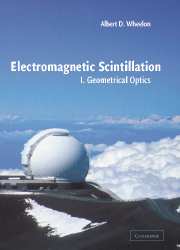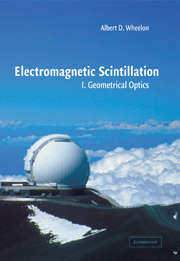Electromagnetic Scintillation
Electromagnetic scintillation describes the phase and amplitude fluctuations imposed on signals that travel through the atmosphere. Providing a modern reference and comprehensive tutorial for this subject, two volumes cover optical and microwave propagation, integrating measurements and predictions at each step of development. The first volume (published September 2001) dealt with phase and angle-of-arrival measurement errors, which are accurately described by geometrical optics. This second volume concentrates on amplitude and intensity fluctuations of the received signal. Also available...Volume I 0-521-80198-2 Hardback $110.00 C
- Provides a modern, comprehensive reference for all aspects of electromagnetic scintillation
- Tailored to the needs of practitioners: astronomers, applied physicists and engineers
- This tutorial presentation integrates predictions and measurements
Reviews & endorsements
"Providing a modern reference and comprehensive tutorial for this subject, this volume concentrates on amplitude and intensity fluctuations of the received signal." Bulletin of the American Meteorological Society
"The author is to be congratulated and thanked, for writing this comprehensive treatment of the scintillation of electromagnetic waves over a broad spectrum, from visible light to radio waves...Everyone specializing in electromagnetic scattering should have these volumes on his/her desk or in a nearby library."
Product details
December 2004Adobe eBook Reader
9780511057083
0 pages
0kg
116 b/w illus. 12 tables
This ISBN is for an eBook version which is distributed on our behalf by a third party.
Table of Contents
- 1. Introduction
- 2. The Rytov approximation
- 3. Amplitude variance
- 4. Spatial covariance
- 5. Power spectrum and autocorrelation
- 6. Frequency correlation
- 7. Phase fluctuations
- 8. Double scattering
- 9. Field strength moments
- 10. Amplitude distributions
- 11. Changes in polarization
- 12. The validity of the Rytov approximation
- Appendices
- Indexes.





